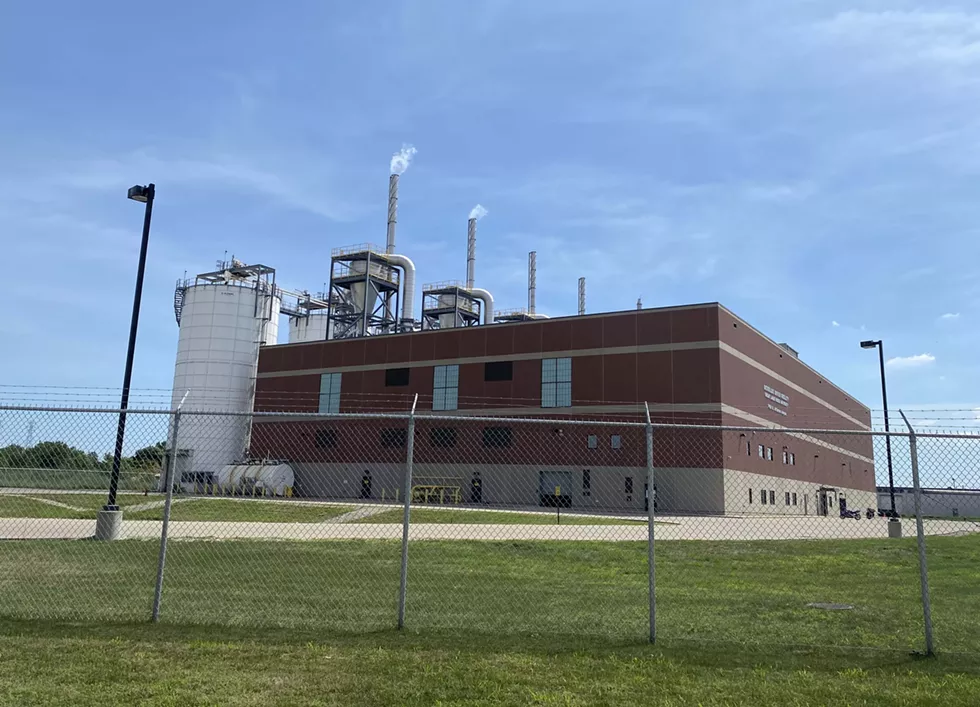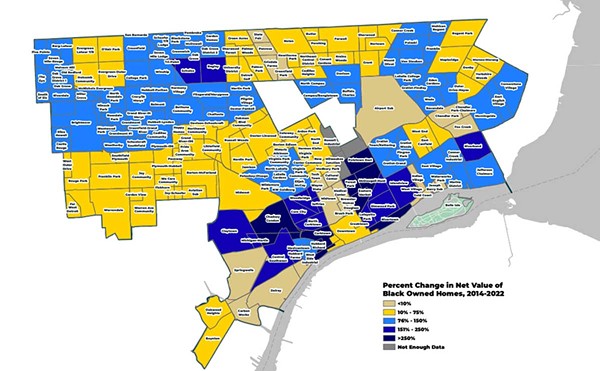Each day, tons of human excrement flows from southeast Michigan's toilets to its sewer system, mixing with industrial waste from Zug Island, Ford's auto plants, Detroit Receiving Hospital, and every factory, industry, home, and commercial building in the region.
Once it reaches the Great Lakes Water Authority's (GLWA) treatment plants, water is pulled from the mix, sanitized, and discharged into the Detroit River. What's left behind at the treatment plants is sewage sludge — a highly toxic, semi-solid blend of human feces and every pollutant that was discharged into the sewers.
Despite the fact that it teems with potentially dangerous chemicals, the sludge is then spread on farmland.
Nutrients in human excrement, like phosphorus and nitrogen, help plants grow, so sewerage departments across the country lightly treat sludge and repackage it as a fertilizer called "biosolids" that are given away or sold for cheap to farmers.
Biosolids are a "valuable resource" that has been "shown to produce significant improvements in crop growth and yield," according to the Environmental Protection Agency, which approved the practice in the mid-1990s. By 2018, more than 50% of the approximately 130 million wet tons of sludge the nation produced annually was applied to farmland.
But the practice is increasingly controversial. Public health advocates say any amount of the approximately 90,000 synthetic chemicals in existence, from VOCs to BPAs to PCBs, can be represented in sludge. It can also be packed with superbugs, parasites, worms, hormones, viruses, and bacteria that aren't killed in the treatment process.
Studies show the pollutants are carried to farmland, taken up by crops, and can end up on dinner plates. That's fueling a growing number of biosolid-linked public-health crises that are making people sick, polluting drinking water, and pitting farmer against farmer.
In Michigan, officials are discovering sludge packed with toxic PFAS, and a growing alliance of farmers, public health advocates, and environmentalists are calling for a ban on spreading the substance on cropland.
"The best solution is to get this stuff off the market," says Christy McGillivray, legislative director of the Sierra Club of Michigan. "Anything that was flushed down the toilet — any hazardous chemical that we use in our everyday systems — winds up in a wastewater treatment plant, so there are a lot of questions about biosolids' safety."
Municipalities in Michigan, Wisconsin, and Florida, among others, have prohibited biosolids, while Maine has restricted their use. In 2003, Switzerland became the first country to outlaw them, and businesses like Whole Foods and Del Monte tell Metro Times they won't buy crops grown in sludge.
But the powerful waste-management industry and regulators are resistant to prohibition. Sludge is an expensive byproduct that's difficult to dispose of, and selling it to farmers is a cheap solution to the problem. In a statement to Metro Times, the GLWA — which churns out more biosolids than any of the nation's other sewerage authorities — insisted its sludge is safe.
Though state regulators "expect" PFAS to be present in sludge, Scott Dean, a spokesman with the Michigan Department of Environment, Great Lakes, and Energy (EGLE), downplayed the threat to human health.
"Due to the fact that biosolids themselves are applied in low amounts in relation to the soil mass in a farm field, they would not be expected to accumulate to the extent to cause adverse effects to public health or the environment," he said.
He noted that EGLE is forcing many PFAS polluters to stop discharging the chemical into sewers, but the state doesn't plan to test for most of the other 90,000 chemicals that exist.
'You're going to drop dead'
In a scathing 2018 report, the EPA's Office Of Inspector General wrote that it found 352 contaminants, including 61 it classified as "acutely hazardous, hazardous, or priority pollutants" in biosolids it tested. Among other substances, it detected PFAS, pharmaceuticals, steroids, and flame retardants.
Despite the potential for high toxicity, federal law only requires wastewater treatment plants to consistently monitor for nine heavy metals, intermittently test for other contaminants and kill most pathogens and living organisms by using heat or dolomitic lime. The latter lowers the ph to make it more acidic and inhospitable to organisms.
The EPA's OIG found the agency can't properly regulate sludge because it doesn't have the tools to assess the safety of all the other pollutants found in biosolids.
"Biosolids [have] everything that goes down the drain from funeral homes to slaughterhouses to everyone's toilet that's hooked up to the sewer system," says David Lewis, a former EPA microbiologist opposed to the use of biosolids. "All of these things are unsafe, according to scientific literature, so how does adding lime and putting it on land make it safe?"
Moreover, individual chemicals that aren't dangerous on their own can become toxic when mixed. Lewis likens the situation to going into a pharmacy, grabbing different bottles off the shelf, and swallowing pills.
"You're going to drop dead, and that's what we're doing with sludge," Lewis says.
A growing body of evidence highlights the risks. A 2013 University of North Carolina study found 75% of people living near farms that spread biosolids experienced health issues like burning eyes, nausea, vomiting, boils, and rashes. A University of Georgia study found similar issues, while others living near sludge fields have contracted MRSA, a penicillin-resistant "superbug."
Lewis investigated two deaths near fields where sludge was spread and found that the substance triggered reactions that killed the two people. More recently, he's linked the substance to autism.
In Georgia, sludge killed an entire herd of cows. In Maine and New Mexico, farmers last year had to put down herds of cows found to be filled with PFAS and producing toxic milk. Last week, officials in Maine discovered cows teeming with the highest levels of PFAS ever found in the animals. Meanwhile, biosolid treatment centers are sources of air and water pollution — the substance is thought to be partly responsible for toxic algae blooms in the Great Lakes and Florida.
A brief history of sewage sludge
Before the 1973 Clean Water Act (CWA), industry discharged its waste directly into the nation's waterways. Rivers became so polluted that those in industrial regions like Michigan and Ohio regularly caught fire.
The CWA mandated a proliferation of wastewater treatment plants that would take in human and industrial waste via the nation's expanding sewer system, then spit out clean water into its rivers.
America's waters quit burning, but the solution presented a new problem — sewage sludge. At first, it was dropped in the ocean, but that created large dead zones. Then industry tried burning it, but that often violated the Clean Air Act.
Despite the fact that sludge was too toxic for the ocean or air, the EPA in 1993 approved a rule change that would allow it to be spread on farmland. Lewis says scientists at the agency uniformly opposed the idea, but leadership pressed forward with approval.
"Not a single study demonstrated that this practice was safe," he adds.
These days, when sludge isn't spread on farmland, it's either landfilled or, in some cases, incinerated with pollution controls.
Raising a stink in rural Michigan
Several years ago, Yankee Springs resident Willard Case made an alarming discovery — nitrate levels in his property's wells had spiked.
While nitrates are found naturally in groundwater, and at low levels aren't a problem, high levels can cause health problems, especially for children and pregnant women. Case contacted local health authorities, but says they only instructed him to dig more wells to find clean water.
However, his attempts to do so only yielded contaminated water, and Case says the source of the contamination is obvious: A neighboring business had applied one million gallons of sludge to its property, while two other farmers in the small farm town 35 minutes south of Grand Rapids filled their fields with biosolids.
Case says he contacted EGLE and the agency found PFAS in the sludge, but it isn't initiating a cleanup. It tested for PFAS, but Case says he's worried about other chemicals that could be in the biosolids or in his well. He calls the situation "disturbing."
"They're only checking for PFAS because that's the loudest bell ringing, but I think there are other chemicals in there," Case says. "They're injecting the ground with this stuff and impregnating it with chemicals that we can't control. We're going to lose these beautiful farm fields."
Case's problems with his neighbors' sludge is emblematic of the types of disputes playing out in rural areas across Michigan. Neighbors of farmers who spread sludge say they fear well contamination and pollution of local waterways that serve entire farm communities. Several farmers told Metro Times that the smell is terrible. Don Dickerson, a farmer with land in Michigan and Ohio, said he found his home and property coated in sludge dust after his neighbor applied it.While Michigan municipalities can't specifically prohibit farmers from spreading sludge, Summerfield Township, which sits about 20 miles west of Monroe, passed a broad waste disposal ordinance that covers potential contamination and is applicable to all industries.
“It’s crazy — they’re playing Russian roulette with our health,” one resident says.
tweet this
Summerfield Township Supervisor John Chandler says the township's leaders are responding to a public health need and demand from residents who don't want it spread near their homes.
"Maybe sludge is safe and maybe it's not so safe," Chandler says. "But it's too risky. We stand on that as a township, and say 'Go spread it somewhere else' because we don't want it here. Nobody I know is for sludge, and I would say anybody who would be for it is likely a farmer who wants free fertilizer."
The earth in the region around Summerfield is cracked and filled with sinkholes, Chandler adds, and that makes sludge especially risky in terms of contaminating groundwater and wells.
"My worry is what the heck is in it?" Chandler asks. "And how would you ever remediate that?"
Is free fertilizer worth the cost and risk?
Case says there's too much at stake."It's crazy — they're playing Russian roulette with our health," he says.
PFAS: A farm-to-table toxin
For years, Michigan regulators told residents that biosolids were safe as farmers unknowingly spread PFAS-laden sludge on cropland. Then it became clear that PFAS presents a threat to human health.
Over the last two years, EGLE discovered PFAS in sludge at 41 wastewater treatment plants, but the agency has only tested about a quarter of the state's 400 facilities. It ultimately ordered five plants to stop sending sludge to farmers.
Public health advocates say the PFAS issue highlights biosolids' fundamental problem — no one knows what other dangerous chemicals are lurking in it.
"Regulators completely miss emerging contaminants — like PFAS — as well as pharmaceuticals and a whole host of other chemicals used widely today that find their way into crops," says Colin O'Neil, legislative director at Environmental Working Group, which tracks PFAS contamination.
PFAS, or per- and polyfluoroalkyl substances, are toxic chemicals used to make a wide range of products water- and stain-resistant. About 7,500 varieties exist, and those that have been studied are linked to cancer, thyroid disorders, autoimmune disorders, deformities in newborns, liver disease, and a range of other serious health issues.
Current surface water recommendations are set at 70 parts per trillion for PFOS and PFOA — two types of PFAS — in drinking water. In sludge, the state has found an alarming median of nearly 70,000 ppt in sludge, though there are no environmental quality standards for biosolids.
State records pulled from the MIWaters website show how the dangerous chemicals can make their way from industry to Michiganders' food.
In November 2018, a US Ecology-owned toxic-waste landfill in Van Buren Township discharged water with PFOS levels as high as 60 ppt. Records show neighboring landfills sent out water with levels as high as 420 ppt.
En route to a wastewater treatment plant, that mixed with PFAS-laden discharge from the region's other industries. The plant treated the sludge and produced biosolids with 25 different types of PFAS totaling over 32,000 ppt.
The biosolids were then shipped out to farmers and spread onto cropland or sent to landfills. Though there are no limits on PFAS in biosolids, the 32,000 ppt should raise alarm, O'Neil says.
"Where they're finding PFAS, [farmers] need to be alerted to that fact, as that might inform whether or not they choose to spread biosolids on the farm in the first place," he says.
In a written statement to Metro Times, Dean says EGLE doesn't directly alert farmers when high levels of the chemicals are found in sludge.
'We can all surmise that it's not good'
So how much PFAS and other dangerous contaminants ultimately make it to our food? That's unclear, but there's evidence that it does, and that's especially true for PFAS, which easily move through the environment.
Still, regulators haven't acted quickly, and there's no clear picture of the health impact, says Denise Trabbic-Pointer, a former DuPont chemist who now tracks PFAS contamination for the Sierra Club.
"We can all surmise that it's not good, but nobody knows what the number is," she says. "I wish that [regulators] would put a little more effort into looking at it, worrying about it, and following through on it."
A recent veterinary study found that sludge caused reproductive problems in sheep grazing in fields on which farmers spread sludge. The findings "highlight potential risks" for humans and animals, said Dr. Richard Lea, the study's author.
"There are quite worrying implications for female fertility in the human," he wrote, adding that "there's a very high chance" that the chemicals would end up in humans who eat the meat.
Researchers found the sheep had absorbed high levels of phthalates and PCBs, which each cause a range of serious health problems like cancer and early puberty in children.
Multiple other studies found pharmaceuticals and other chemicals in plants grown in sludge.
In Maine, farmers who spread biosolids on a cattle farm have blood with the highest PFAS levels on record in a Maine resident.
Even though Michigan agriculture officials have acknowledged that PFAS are in the state's cows, an official said last year that regulators won't test milk, for fear of the damage it could do to the dairy industry.
Safe sludge?
EGLE's Dean, however, notes that the state is taking some serious steps to reduce PFAS levels in sludge. In some cases, PFOA and PFOS levels dropped by about 90% after EGLE identified industries discharging the chemicals into sewers and required them to stop doing so.
EGLE is also testing fields on which contaminated biosolids have been spread to determine how much PFAS is in soil and crops. That will give regulators a clearer picture of how much of the chemical moves from the sewer to Michiganders' dinner plates. PFAS have already been found in corn in a Lapeer field.
"EGLE is a leader in studying PFAS in biosolids through our work to protect public drinking water from these contaminants," Dean says.
In a written statement sent to Metro Times, the Great Lakes Water Authority stressed that it follows the law in testing for contaminants and said it monitors for new pollutants of concern, like PFAS.
"As regulatory agencies identify emerging pollutants, GLWA works with the agencies to develop and implement plans to minimize or eliminate the pollutant from our wastewater discharge," a spokesperson wrote.
But critics say there are flaws in EGLE's approach. It's only regulating two of the 7,500 types of PFAS, though it will soon start testing for five more. It also doesn't consider the cumulative total of each type of PFAS. In a hypothetical scenario, water could have dozens of different types of PFAS that collectively present a dangerous level of the chemicals. But if each is below its individual recommended limit, then it's considered safe.
Despite the uncertainty, Dean says EGLE won't act until it can be proven that the PFAS levels in biosolids are unsafe. He also claimed that there isn't evidence to show that all varieties of PFAS found in water are toxic. However, there's a growing body of data that shows all PFAS present a danger — including the chemical companies' own science and reports from the EPA.
The state's approach puts residents' health and safety second to industry, says McGillivray. She argued that the state should gather data to prove that sludge is safe before allowing it to be spread on the state's food supply.
Moreover, even if all the PFAS are removed from sludge, "every toxic organic chemical that exists on the planet, and everything in municipal and industrial waste remains," says former EPA scientist Lewis.
"When you potentially mix every chemical that exists, you get a mixture that has everything in the universe of pollutants, neurotoxins, carcinogens — you can't get away from that," Lewis adds. "So pulling one chemical out of the universe isn't going to make a difference."
Stay on top of Detroit news and views. Sign up for our weekly issue newsletter delivered each Wednesday.







